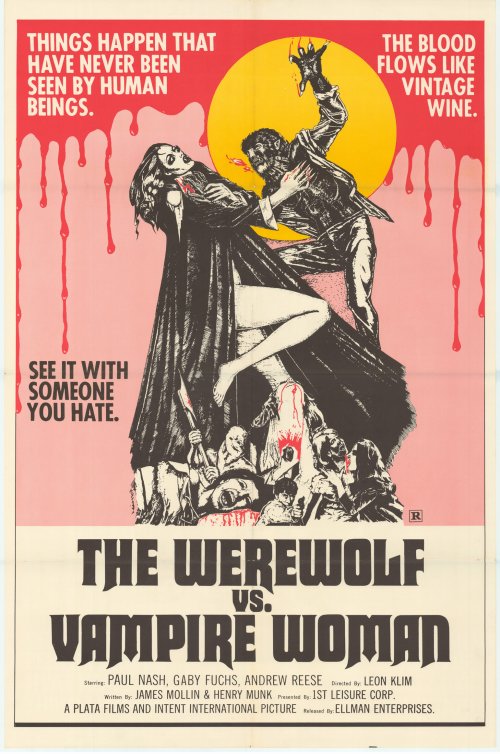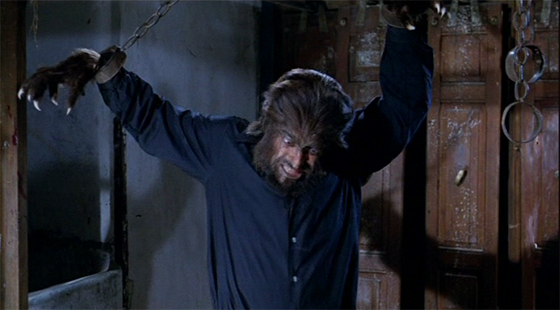
The uninitiated might ask, Who is this Paul Naschy? Why has he been compared to Lon Chaney? Why have books been written about him; why has a fervent cult following developed around his name? Photos of the actor prove unremarkable: an almost comically ordinary-looking schlub. But the light of the full moon reveals a fur-covered face bearing an uncanny resemblance to Universal’s Wolf Man. In fact, La noche de Walpurgis (1971), a werewolf movie which proved to be a tremendous success for Naschy and launched a wave of Spanish horror films in the 70’s, deliberately recalls those Universal Studios monster mashes of the 40’s such as Frankenstein Meets the Wolf Man (1943). No wonder that the film was distributed in the U.S. in cut-up form as The Werewolf vs. the Vampire Woman, appealing directly to American “Monster Kids” who would otherwise have no familiarity with this Naschy fellow. (Call the film what you will: a literal translation of the title is “Walpurgis Night,” a holiday obscure to American audiences. The alternate English-language title is Werewolf Shadow, which the BCI Eclipse DVD uses. An earlier video copy was distributed under the title Blood Moon.) León Klimovsky, a prolific director who made films in both Spain and his native Argentina – and signs his name in the opening credits a la Cocteau – updates the formula to the more permissive 70’s with bare breasts and spurting blood (not to mention some boozy lounge music). Charmingly, at its core La noche de Walpurgis is simply a love letter to monster movies.
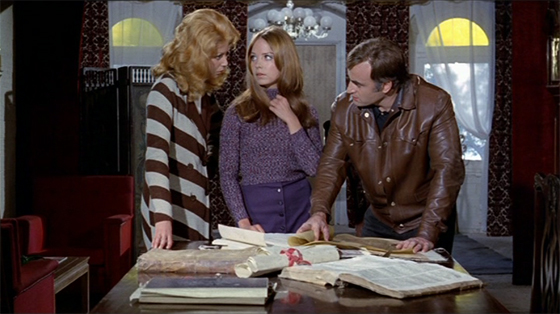
Students Elvira (Gaby Fuchs) and Genevieve (Barbara Capell) accept the help of Waldemar Daninsky (Paul Naschy) to research the legend of a devil-worshiping countess.
Naschy reprises a role he had played before, and would play time and again: the haunted werewolf Waldemar Daninsky, who – like Larry Talbot before him – can’t help that he spends his nights tearing out throats; certain films in the series reference an encounter with a Yeti that led to this condition, and a passing reference to an incident in Tibet is made in this film. (So…shouldn’t he be turning into a Yeti? Or an ape? Never mind; it really doesn’t matter.) The opening scene of La noche de Walpurgis sets the mood perfectly: lying on a slab in a morgue, the dead Naschy is inspected by a mortician and doctor who express skepticism that the man was an “Hombre Lobo” as the villagers claim. The first step in the autopsy: “I’m going to take out the silver bullets,” says the doctor, “and I assure you he’ll stay as dead as before.” The bullets are removed – the full moon is revealed by the parting clouds – and a hairy claw lunges for the doctor. After the credits, the film awkwardly fixes the story in France by showing us an extra browsing through postcards of the Eiffel Tower. We meet a grad student, Elvira (Gaby Fuchs, Mark of the Devil), who explains to her boyfriend, a police inspector named Marcel (Andrés Resino), that she’s writing a thesis on the Hungarian Countess Wandesa Dárvula de Nadasdy (Patty Shepard, Assignment Terror), an Elizabeth Bathory type who sold her soul to the devil and practiced witchcraft. (The flashback is triggered by a psychedelic kaleidoscope projected onto Elvira’s face, and then onto the face of the Countess.) Hunted as a witch, she was finally killed by being stabbed in the heart with the silver Cross of Mayenza. Elvira travels into the French countryside to find the Countess’ tomb and complete her studies, accompanied by her beautiful friend Genevieve (Barbara Capell, Should a School Girl Tell). Low on gas and stranded near the ruins of a monastery, the girls are relieved to encounter Waldemar Daninsky, a writer who invites them to stay for the week at the home he’s renting. He doesn’t tell them about his need to chain himself to manacles suspended by the ceiling on nights of the full moon.
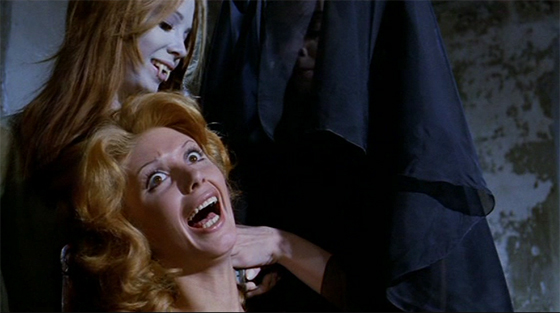
Elvira discovers that her friend Genevieve has been made a vampire by the undead Countess de Nadasdy.
When Daninsky helps the girls open the tomb of the Countess (so Elvira can snap some photos, naturally), Genevieve accidentally cuts her wrist and splashes blood on the mouth of the skeletal corpse. She notes that the legend indicates the Cross of Mayenza shouldn’t be removed from the Countess’ chest or she’ll return to life as a vampire; Daninsky says dismissively, “It’s only a legend,” and walks off with the cross in his hand. (Thanks, Waldemar.) Shortly thereafter, a monk-turned-ghoul is chasing Elvira through the ruins, and Daninsky saves her life by attacking it with the cross. This, after Daninsky’s seemingly-deranged sister Elizabeth (Yelena Samarina) has already attacked Genevieve in a room full of bloodstains, chains, and torture devices (she was actually protecting her brother’s secret). Nonetheless, the girls stick around a little longer. Sure enough, the Countess has been revived; she preys upon Genevieve and transforms her into a vampire, who begins to stalk her friend through the hallways of the chateau, the floors carpeted by undulating fog. Daninsky’s assistance is severely hampered by his lycanthropy; on the night of the full moon, he breaks loose of his chains and embarks on a rampage through the woods. When Inspector Marcel shows up to save Elvira from her host, whom he’s convinced is a dangerous killer, he’s dismayed to find that she’s fallen in love. All that can resolve the triangle is the expected werewolf vs. vampire woman climax on Walpurgis Night, with Marcel and Elvira in chains, and El Hombre Lobo wrestling in the dirt with the fangs-sporting Countess on a set decorated with coffins and pentagrams.
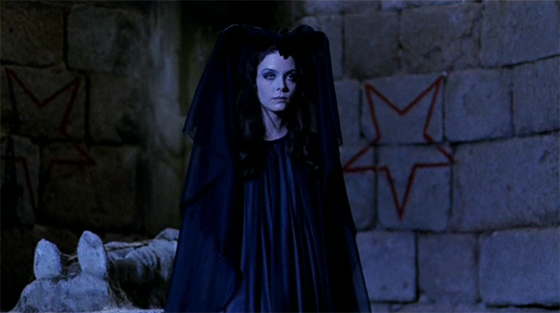
The vampire Countess (American-born Patty Shepard) rises from her coffin to enact a Satanic ritual on Walpurgis Night.
Klimovsky proves his mettle with the atmospherics; the film is sufficiently dream-like, with an effective use of slow-motion during the vampire and ghoul attacks. (The werewolf attacks, on the other hand, are quick and brutal.) The transformations, by necessity, must stick to the rules from the Jack Pierce era of monster makeup, and if the effects are by comparison crude, one must take the modest budget into account. This German/Spanish co-production features an international cast, and, as with Italian films from the period, even the native-language print is dubbed. Quite a lot of exposition is packed into the film’s 91 minutes, including some dialogue scenes that get a bit draggy (some of them were cut from the American release), but for the most part the film affectionately crams in as many monster movie tropes as it can, paying equal homage to Dracula – with Elvira and Genevieve enacting the roles of Mina and Lucy, respectively – as it does The Wolf Man. The soundtrack is just as busy, choked with howling wind, organ music, discordant keys, and moans, shrieks, and wails – offset, jarringly, by the la la la las of its swinging main theme. Paul Naschy – short and stocky, his bare chest made up with scars and the scorched sign of the pentagram – may be an unlikely sex symbol for the nascent genre of Spanish horror, but La noche de Walpurgis fixes him firmly into that role with demented confidence.
